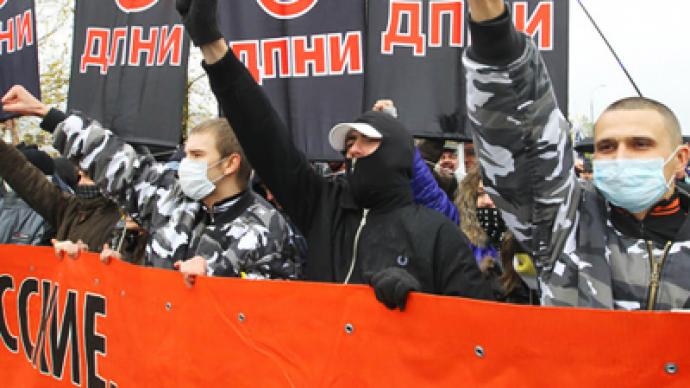National Unity Day marked with nationalist marches

Several nationalist marches have been held across the country as Russia is celebrating the Day of National Unity.
In Moscow, authorities gave permission to several nationalist groups, including the “Movement against Illegal Immigration” (DPNI) and “Slavic Force”, to stage a rally of up to 5,500 people.Chanting “Russia is for Russians, Moscow is for Muscovites”, the activists – mainly youngsters – marched from Lyublino to Maryuno subway stations on the capital’s outskirts. They were holding flags with nationalist symbols and slogans demanding that immigrants be sent back to their countries.According to Interfax news agency, several people were detained after a scuffle during the rally.Similar nationalist gatherings have been staged in other Russian cities including St Petersburg and Novosibirsk.In recent years Russia has seen a huge increase in immigration with thousands of migrant workers from former Soviet republics – mainly Central Asia – coming to the country to seek better life conditions or simply to earn money to support their families. Many Russians are not too happy about that and want the government to address the issue and come up with a balanced policy on immigrants.However, allowing nationalists to stage their rallies causes concern among human rights activists, especially since xenophobic crimes are on the rise in Russia."It is necessary to guarantee freedom of expression to people, but I do not think that such actions can bring any benefits," the head of the Federal Migration Service, Konstantin Romodanovsky, told Interfax. "What ideas are they expressing? What are they protesting against? Against the grandchildren of those who defeated the Nazis? What is good about that?"Meanwhile, the pro-Kremlin youth movement “Nashi” (Ours) along with the “Stal” (Steel) and “Our Homes” staged a 20,000-strong rally – the so-called “Russian March” – in the capital’s center. The activists were waving placards reading “Russia’s Pride” and portraits of the WWII veterans. Another group was marching through Moscow with portraits of those they consider to be the country’s “shame” – drug dealers, illegal casinos owners, and people who have sold alcohol to minors.The activists also appealed to the new Moscow Mayor Sergey Sobyanin, suggesting he enlist their help in making the capital better.After the rally, the youngsters split into small teams in order to film video clips on places that sell expired products and other cases of violation of the law in the capital. The results of the investigation will be passed to the Moscow government and law enforcement agencies.“Our Russian March is a march in support of Russia,” Nashi leader, Maria Kislitsyna said earlier, as cited by the movement’s official website. “Tens of thousands of young people have united to make their contribution to forming an attractive image of the capital. It is our country and we will live here. Therefore, we are going to fight against the disregard of law which we witness almost every day,” she stated.One of the newest public holidays in modern Russia, the Day of National Unity, was introduced by then-president Vladimir Putin’s decree in 2004 and has been celebrated on November 4 since 2005. It replaced the main holiday of the Soviet-era, the anniversary of the 1917 Bolshevik Revolution, which was celebrated on November 7.The roots of the holiday date back to the 17th Century. In November 1612 (October in the Julian Calendar) a Russian volunteers corps led by Kuzma Minin and Dmitry Pozharsky managed to expel the Polish-Lithuanian occupation force from Moscow, which also led to the end of the Time of Troubles and foreign intervention in Russia in the Polish-Muscovite War (1605–1618). In that rather harsh period of the country’s history, there was no tsar to guide the people. However, the entire population, no matter which social class, nationality or religious group they belonged to, united for the sake of the statehood future and pushed the aggressors out of the country.In 1649, Russian Tsar Alexey Mikhailovich Romanov declared November 4 (October 22) a public holiday, which was celebrated until the Bolsheviks came to power in 1917.The revived holiday, though, has not become popular with the majority of the population. While people quite enjoy having an extra day off, many still have no idea of what actually is being celebrated. According to a poll carried out by Russia’s Public Opinion Research Centre, VCIOM, only ten per cent of the population are aware that November 4 is the Day of National Unity and can explain why it is celebrated. Only one per cent of those questioned consider this holiday important.Natalia Makarova, RT












